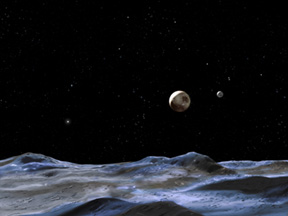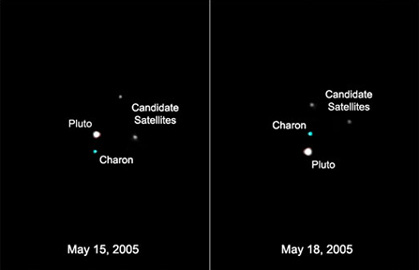Geotimes

Untitled Document

Web Extra
Thursday, November 3, 2005
Two more moons for Pluto
 When the New
Horizons spacecraft finally reaches Pluto in July 2015, researchers will have
more objects to study than previously thought. In addition to Pluto's confirmed
moon Charon, astronomers have detected two more orbiting celestial bodies, which
could help reveal how the planet and moon system formed.
When the New
Horizons spacecraft finally reaches Pluto in July 2015, researchers will have
more objects to study than previously thought. In addition to Pluto's confirmed
moon Charon, astronomers have detected two more orbiting celestial bodies, which
could help reveal how the planet and moon system formed.
This artist's rendition portrays how
the Pluto system might appear from the surface of one of the recently discovered
moons: Pluto is the large object near the center with Charon to its right and
one of the new discoveries to the left. About 5,000 times fainter than Pluto,
the moons remained undetected until May. Image courtesy of NASA, ESA and G.
Bacon of the Space Telescope Science Institute.
The two faint objects were first noticed in a May 15 Hubble Space Telescope
image by team member Max Mutchler of the Space Telescope Science Institute.
Three days later, the team looked at more Hubble images to find out if the objects
were moons in orbit with Pluto or just objects passing nearby. Hubble revealed
that the two objects appeared to be moving counterclockwise in orbit around
Pluto, making them satellites of the planet. The team formally communicated
their findings in a bulletin released by the International Astronomical Union
this week, and it plans to submit three papers to refereed journals.
Astronomers previously missed the moons because of their small size and low
luminosity, about 5,000 times fainter than Pluto. "The comparatively blinding
glare of Pluto really washes them out and makes it difficult to see small, faint
satellites that are in relatively close," says Dan Durda, an astronomer
at the Southwest Research Institute in Boulder, Colo. "If you're not carefully
looking for them, it's very easy to overlook them."
Most astronomers consider Pluto to be the ninth planet, but they also consider
Pluto to be a member of the icy and rocky disc of debris at the edge of the
solar system called the Kuiper Belt. If the bodies discovered in Hubble Space
Telescope images last May are indeed orbiting Pluto, then the investigating
team of astronomers from the Southwest Research Institute and other institutions
say that Pluto is now the first Kuiper Belt object discovered to have more than
one moon.
 Pluto, however,
is not the only Kuiper Belt object to have a moon — about a dozen more
Kuiper Belt objects have one orbiting companion. Paul Schenk, a planetary geologist
at the Lunar and Planetary Institute in Houston, Texas, says that he was not
surprised to learn that Pluto had moons, but was more interested in the fact
that the moons had maintained a stable orbit. "It's like a juggler managing
four objects at once," Schenk says.
Pluto, however,
is not the only Kuiper Belt object to have a moon — about a dozen more
Kuiper Belt objects have one orbiting companion. Paul Schenk, a planetary geologist
at the Lunar and Planetary Institute in Houston, Texas, says that he was not
surprised to learn that Pluto had moons, but was more interested in the fact
that the moons had maintained a stable orbit. "It's like a juggler managing
four objects at once," Schenk says.
Hubble Space Telescope
images show Pluto with its large moon Charon, along with the planet's two new
candidate satellites. Between May 15 and May 18, Charon and the two objects
appear to rotate counterclockwise around Pluto. Image courtesy of NASA, ESA,
H. Weaver (JHU/APL), A. Stern (SwRI), and the Hubble Space Telescope Pluto Companion
Search Team.
The leading hypothesis for how the system formed, Durda says, is that another
Kuiper Belt object collided with Pluto early in its history to create Charon.
If an impact were responsible, then astronomers might expect to find leftover
debris. "To actually see what could presumably be some of that leftover
debris, is supporting evidence for that hypothesis," he says.
The other method by which Kuiper Belt objects obtain moons is through gravitational
capture of passing objects. Those systems, however, tend to have loosely bound
moons that are farther away from the planet; Pluto's moons are relatively close,
which, Durda says, lends additional support to the collision hypothesis.
More observations and analyses are needed, however, before astronomers can
fully support one formation theory over the other. For example, they would like
to know whether or not the moons are composed of the same materials as Charon;
if the composition were the same, that evidence would further support that a
collision was responsible for the moons.
The basic physical properties, such as size, exact brightness and orbital characteristics,
will also be the subject of future research. "I can guarantee there will
be all kinds of follow-up," Durda says. "It's going to swing into
high gear now."
This discovery comes at a time when Pluto's very definition as a planet has
been in debate. Some astronomers argue that Pluto is merely a large Kuiper Belt
object — a concept supported by the presence of bodies in the belt that
approach and even surpass Pluto in size. Whether or not the discovery of multiple
moons will clear the debate over Pluto's status as a planet remains to be seen.
According to Schenk, Pluto should be called a planet only because of historical
precedence. "If we found it today, we would probably call it a larger member
of the outer asteroid belt," Schenk says.
But Durda says that the name is not important: "Pluto is an intrinsically
interesting planetary object, whether people call it a planet or not,"
he says. "It's a wonderful representative of many of these objects out
there in the Kuiper Belt, and it's a perfect target for the New Horizons mission."
Kathryn Hansen
Links:
Southwest
Research Institute Department of Space Studies
New
Horizons mission information
Background
information regarding Pluto's satellites
Back to top
Untitled Document

 When the New
Horizons spacecraft finally reaches Pluto in July 2015, researchers will have
more objects to study than previously thought. In addition to Pluto's confirmed
moon Charon, astronomers have detected two more orbiting celestial bodies, which
could help reveal how the planet and moon system formed.
When the New
Horizons spacecraft finally reaches Pluto in July 2015, researchers will have
more objects to study than previously thought. In addition to Pluto's confirmed
moon Charon, astronomers have detected two more orbiting celestial bodies, which
could help reveal how the planet and moon system formed. 
 Pluto, however,
is not the only Kuiper Belt object to have a moon — about a dozen more
Kuiper Belt objects have one orbiting companion. Paul Schenk, a planetary geologist
at the Lunar and Planetary Institute in Houston, Texas, says that he was not
surprised to learn that Pluto had moons, but was more interested in the fact
that the moons had maintained a stable orbit. "It's like a juggler managing
four objects at once," Schenk says.
Pluto, however,
is not the only Kuiper Belt object to have a moon — about a dozen more
Kuiper Belt objects have one orbiting companion. Paul Schenk, a planetary geologist
at the Lunar and Planetary Institute in Houston, Texas, says that he was not
surprised to learn that Pluto had moons, but was more interested in the fact
that the moons had maintained a stable orbit. "It's like a juggler managing
four objects at once," Schenk says. 